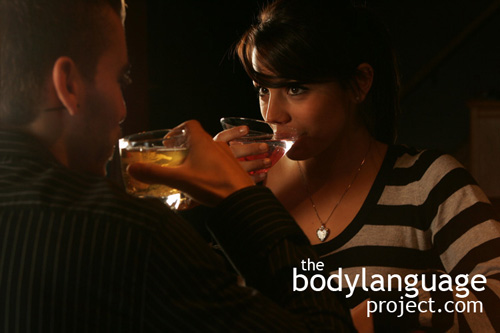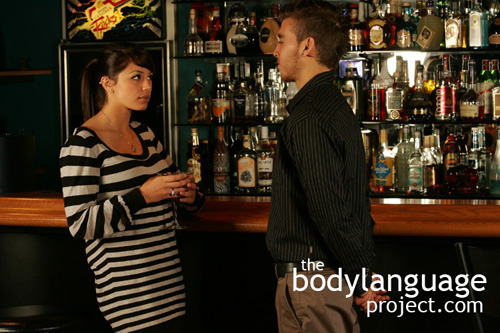Mirroring or “isopraxis” is as important to lifelong friends as to strangers meeting for the first time, since mirroring is a way to test and maintain the level of rapport being established between two people or groups of people. Mirroring as it applies to nonverbal communication describes body postures, body positions and gestures that are held in unison or echoed a few seconds later, across people as they interacting. When full mirroring appears it is as if each person is looking into the mirror and seeing their reflection. When full mirroring happens, it indicates a high level or rapport, or connectivity between people.
We mirror as a form of bonding with one another, and it happens without our conscious awareness. In fact, mirroring is difficult to carry out in a natural way at a conscious level as we will see in this chapter. The evolutionary origins of mirroring might stem from imitative learning, where gestures and movements or skills are passed from one person to another. Children learn to imitate our facial expressions and quickly graduate to imitating our body positions, and then later they imitate us as we carry out tasks. If you’ve even driven with a youngster, you’ve watched them pretend to drive with their arms up, rocking the wheel left and right, or working the stick shift. Imitation has been said to be the greatest form of flattery and in mirroring this is the case.
In ancient times, mirroring would have created group cohesion and identity. Sports groups, riot officers, firemen, and a myriad of occupations all wear the same uniform. It is this dress that formulates the beginnings of the behaviour that eventually leads to a group’s ability to functioning in unison. Imagine if policemen all showed up in different dress and tried to control a crowd. To the rioters, they would seem as if they were rogue rioters themselves which would only exacerbate the problem. The rioters would identify the policemen as part of their group instead of part of the police group, which would only lead to additional chaos.
However, the police know the importance of mirroring, so they arrive with exactly the same gear, dress and comportment. They wave their batons, walk, stomp and chant in unison to display a fortified front. The uniform also serves to identify members of their group and dispel others quickly. A rioter who was able to secure a loose baton wouldn’t last long in the group in the group of police, even if he could adopt the same postures, chants and stomps, because he’d still lack the proper uniform. However, if he could obtain this too, he’d fit right in and would be accepted as part of the group without question. The results of this would be devastating, since his behaviours, no matter how random or unjust, would be tolerated by his “peers”. He could begin to smash windows or beat up other rioters and it would be initially overlooked by his group causing confusion. The uniform, because of mirroring and rapport, provides the rogue officer with additional powers, so he can get away with things that a rioter can not. This extension of power only lasts so long before it would be questioned though, and the same sort of behaviour is present in real life situations as it relates to mirroring. It builds rapport and group cohesion and identifies those that belong to us and fit in with our ideologies, and those that do not. When we are in groups we easily loose our individual mentality in favour of group cohesion. The rioters escalate their terror for the same reason. They are part of a group, identify with it and so adopt similar behaviour.
Mirroring and uniforms do not apply just to the police. In fact, it applies to almost every walk of life, in every office or business across the planet. We act and dress a certain way even when we are relaxing with friends. When we go to concerts we clap, sing, stand, drink and with the right group, listening to right music, may even join a mosh pit with others to slam our bodies together violently to celebrate the music. Mirroring says that we are on the same page. It’s like saying look at the two of us, we walk the same, talk the same and our bodies move in unison, therefore we must agree. Mirroring can cut so deep that breathing, blinking, and even our heart rates can beat in unison. Mirroring is such a profound quality of social animals as a whole. Our cities are built upon our abilities to mirror with row upon row of houses repeating one after the other, all with a small patch of green grass at the front and hopefully a bit more at the back. We all cut it short to make it presentable and to keep up with our neighbours. We compete with others just to fit in and be the same as them. Far from being a bad thing, mirroring creates social order, promotes peace and productivity and leads to cooperation.
Mirroring in rapport building is ubiquitous and serves a purpose but it also finds itself in some peculiar places. Yawning is one of them. Yawning is one of the more pronounced forms of mirroring since it has a contagious element. Yawning in one person sets off a chain of yawns within the rest of a group, even if the members don’t know each other. Picking up a foreign accent or adopting the idiosyncrasies of friends are two forms of subtle mirroring. Full blown mirroring happens when we cross our arms in unison, drink or eat together or even finish each other’s sentences. Twins have been known to connect in such a dramatic fashion that sentence finishing is commonplace and some twins can even begin sentences in unison. Mirroring comes out too in tone of voice, syntax, rhythm and use of pauses. Dancing is another form of pervasive mirroring and without building a connection, dance appear sloppy and uncoordinated. Women might even use it as a selective tool when evaluating potential suitors. If you can’t jive together in a coordinated fashion, can you be expected to raise a family together, what about create a family? Anecdotally, dance has been said to be a reliable predictor of how we perform in bed, so if you prefer a slow passionate dance over a break neck shake, keep this in mind! Let us not leave out facial expressions, emotions and overall mood as a subject to mirroring in others either. This is covered in the pages to follow.



